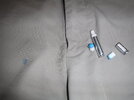peacebutready
Member
There's a video stating the irs bought 5 million rounds of ammo. What kind of pistol ammo did they buy?

I wonder if they practice with the same ammo they carry. That would be mostly wasteful.I agree with what @Chuck R. said. By the time you divide that number by the number of agents then divide that again for each annual or semi-annual qualifications and also divide that number the the number of days spent at the range practicing and those numbers aren't all that big.
The Hanford Nuclear Site up here has guards that get to shoot a lot. They have their own competition team and typically place pretty high in a lot of the state/regional shoots, they're practically paid to do nothing but shoot. Other than those guys that guard nuke sites, one suspects the rest of the federal agencies are super-cheap when it comes to buying ammo.A shooting bud of mine was a Security Guard at Oak Ridge National Lab.
In most law enforcement agencies, it's not just the rounds per qual course, as some departments have different courses of fire and actually afford their officers some warm up rounds and typically a few drills before getting to the required qual course. For example, our handgun qual was 50 rounds, but we typically ran a fifty-round warm up and then several drills using at least 50 rounds each prior to the qual. I always planned on at least 300 rounds per student for the pistol (124 grain FMJ such as American Eagle, duty round was 124 +P Gold Dot),100 rounds for the carbine (55 grain 5.56 FMJ, American Eagle or equivalent, even though the duty round was 62 grain Federal) and 25 for the shotgun (used 7 1/2 shot cheap stuff, duty was Federal LE 00). Semi-annual quals, typically at least three/four classes per month of 10-12 personnel for nine months out of the year (no classes during weeks with holiday weekends).Everyone shoots 40 round during each qualification with the M16/M4.
For pistols each solder fires 30 round per qualification, which is 60 rounds per year per soldier times the number of soldiers issued a pistol.
Highly doubtful. I don't know of any LE agency that does this, way too costly. One suspects the fed bean-counters are even more budget-conscious than most state/local departments. Usually once a year, in my last agency, we'd rotate our department's stock of duty ammo in the armories (only because we had to justify buying our ammo for the next fiscal year, it's not like the ammo goes bad) and have an in-service qual class shoot up the oldest boxes of JHP on hand; every now and then we'd do an instructor update and re-cert and shoot up some of the old stuff as well.I wonder if they practice with the same ammo they carry.
I was the primary firearms instructor for an office of about 200 agents (at the end of my career) for my last 10 years. Quarterly qualifications and training for an agent that carried only one handgun was about 1000 rds a year. Agents were also authorized 100 rds a month for practice. Not everyone took advantage of this. So an agent with one gun was entitled to 2200 rds a year. So that was 440,000 rds for the office to qualify and train 200 agents.I know that government agencies are different from the US military. But I will use an example of US Army brigades. The average Army brigade consists of 3,000 to 5,000 troops. The Army did semi-annual weapons qualifications when I was in for all troops. Some units will spend more time on the ranges than other units.
For a brigade that only shoots twice a year that is between 240,000 and 400,000 rounds per year if everyone in the brigade shoots/qualifies with the M16 or M4. Everyone shoots 40 round during each qualification with the M16/M4.
For pistols each solder fires 30 round per qualification, which is 60 rounds per year per soldier times the number of soldiers issued a pistol.
I don't know what the IRS qualification requirements are. But let's say they are required to qualify twice a year and are also required to shoot 30 round per qualification. For 2,000 agents, that comes out to 120,000 rounds fired just for biannual qualifications and doesn't count practice sessions or the amount of ammo used/carried on a daily basis. Let's say that each agent carries three 15 round magazines daily, that is another 90,000 rounds.
I wonder if they practice with the same ammo they carry. That would be mostly wasteful.

That is simunition training ammo that is non lethal. This type of ammo is generically called simunition even though there are more companies that make it besides Simunition. And yes that stuff is definitely more expensive and will also require adapters depending on the firearm they are used in. This stuff works quite well when you need to make training as realistic as possible without using lethal ammo. Though the blue bullets still hurt when you get hit though.I'd never seen this before, but this stuff has to be more expensive than live ammo. This had to be an expensive drill. They had to use special training pistols to fire the 9mm ammo. They had to replace the bolts in AR's to fire it. It was basically a paintball round. And as you can see I got hit by one of the good guys during one of the drills.
I've used it in force on force training. It has a does have a "sting" and adds a level of realism to the training.That is summation training ammo that is non lethal. This type of ammo is generically called simunition even though there are more companies that make it besides Simunition. And yess that stuff is definitely more expensive and will also require adopters depending on the firearm they are used in. This stuff works quite well when you need to make training as realistic as possible without using lethal ammo. Though the blue bullets still hurt when you get hit though.
I have used it too and it definitely stings more than good quality airsoft guns. And it does add a level of realism not available with blanks.I've used it in force on force training. It has a does have a "sting" and adds a level of realism to the training.
I would hope at least some of the practice would be with carry ammo.I wonder if they practice with the same ammo they carry. That would be mostly wasteful.
That is not always financially feasible, especially for small agencies. FMJ training ammo is normally cheaper that duty ammo.I would hope at least some of the practice would be with carry ammo.
Just in case there is a difference in weapon peformance, POI especially.
I would prefer that all practice be with the same ammo issued for carry.
With Federal primed Federal ammunition, you bet.
We used guns chambered specifically for simulation ammo. You couldn't chamber a live round in them.That is simunition training ammo that is non lethal. This type of ammo is generically called simunition even though there are more companies that make it besides Simunition. And yes that stuff is definitely more expensive and will also require adapters depending on the firearm they are used in. This stuff works quite well when you need to make training as realistic as possible without using lethal ammo. Though the blue bullets still hurt when you get hit though.
We used adaptors when I was in the Army for simunition.We used guns chambered specifically for simulation ammo. You couldn't chamber a live round in them.
It's been some time since I was in National Guard and Reserves but training costs were a big issue. There were minimum requirements but there was flexibility in scheduling what type of training was needed by a unit. One unit might spend some of these flexible dollars into small arms training. Another unit might spend more on mortar training.
